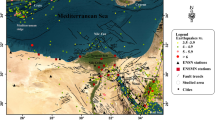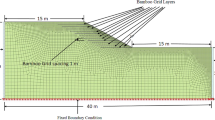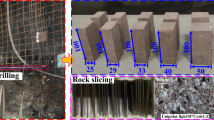Abstract
Ground vibration generated from blasting activities is a major problem in mine open-pit slopes and nearby properties, and it can endanger the inhabitants in the surrounding environment. To understand better the influence of blasting activities in the open-pit mine, it is important to determine the propagation and attenuation of the blast-induced vibration in open-pit slope. This paper presents a predictive model based on the Sadovsky equation for determining blast-induced ground vibration in the **duicheng open-pit mine, Shaanxi province, China. The field observation focused on providing measurements and data collected for the wave propagation with the influence of blasting activities. Empirical models were also used for predicting blast-induced ground vibration for comparison with the Sadovsky model. Blast design parameters such as maximum charge per delay and distance were considered as input parameters for prediction of blast-induced vibration. Site constants for different empirical equations were taken into consideration when determining the peak particle velocities in the **duicheng north slope. The performance indices of R2 (correlation coefficient), MSE (mean square error), RMSE (root mean square error), MAPE (mean absolute percentage error) and MEDAE (median absolute error) were calculated for the empirical models and the Sadovsky model. The results showed that the Sadovsky model is a more satisfactory model for predicting blast-induced vibration as compared to empirical models.





Similar content being viewed by others
References
Ainalis, D., Kaufmann, O., Tshibangu, J.-P., Verlinden, O., & Kouroussis, G. (2016). Assessing blast source pressure modelling approaches for the numerical simulation of ground vibrations. In 23rd international congress on sound & vibration.
Ambraseys, N. N., & Hendron, A. (1968). Dynamic behaviour of rock masses. New York: Wiley.
Armaghani, D. J., Hajihassani, M., Mohamad, E. T., Marto, A., & Noorani, S. (2014). Blasting-induced flyrock and ground vibration prediction through an expert artificial neural network based on particle swarm optimization. Arabian Journal of Geosciences,7(12), 5383–5396. https://doi.org/10.1007/s12517-013-1174-0.
Armaghani, D. J., Mohamad, E. T., Hajihassani, M., Abad, S. A. N. K., Marto, A., & Moghaddam, M. (2016). Evaluation and prediction of flyrock resulting from blasting operations using empirical and computational methods. Engineering with Computers,32(1), 109–121. https://doi.org/10.1007/s00366-015-0402-5.
Armaghani, D. J., Momeni, E., Abad, S. V. A. N. K., & Khandelwal, M. (2015). Feasibility of ANFIS model for prediction of ground vibrations resulting from quarry blasting. Environmental Earth Sciences,74(4), 2845–2860. https://doi.org/10.1007/s12665-015-4305-y.
Bureau of Indian Standards. (1973). Criteria for safety and design of structures subjected to underground blast. New Delhi, India: Bureau of Indian Standards(Bulletin No: IS-6922).
Bye, A., & Bell, F. (2001). Stability assessment and slope design at Sandsloot open pit, South Africa. International Journal of Rock Mechanics and Mining Sciences,38(3), 449–466. https://doi.org/10.1016/s1365-1609(01)00014-4.
Davies, B., Farmer, I., & Attewell, P. (1964). Ground vibration from shallow sub-surface blasts. Engineer, 217(5644), 553–559.
Duvall, W. I., & Petkof, B. (1959). Spherical propagation of explosion-generated strain pulses in rock (Vol. 5481–5485). Washington: US Department of the Interior, Bureau of Mines.
Ekanayake, S. D., Liyanapathirana, D., & Leo, C. J. (2014). Attenuation of ground vibrations using in-filled wave barriers. Soil Dynamics and Earthquake Engineering,67, 290–300. https://doi.org/10.1016/j.soildyn.2014.10.004.
Faradonbeh, R. S., Armaghani, D. J., Majid, M. A., Tahir, M. M., Murlidhar, B. R., Monjezi, M., et al. (2016). Prediction of ground vibration due to quarry blasting based on gene expression programming: a new model for peak particle velocity prediction. International Journal of Environmental Science,13(6), 1453–1464. https://doi.org/10.1007/s13762-016-0979-2.
Ghosh, A., & Daemen, J. J. (1983). Simple new blast vibration predictor (based on wave propagation laws). In The 24th US symposium on rock mechanics (USRMS) (Vol. 2, pp. 151–161). TX: American Rock Mechanics Association. https://doi.org/10.1016/0148-9062(84)91486-4.
Hajihassani, M., Armaghani, D. J., Monjezi, M., Mohamad, E. T., & Marto, A. (2015). Blast-induced air and ground vibration prediction: a particle swarm optimization-based artificial neural network approach. Environmental Earth Sciences,74(4), 2799–2817. https://doi.org/10.1007/s12665-015-4274-1.
Hasanipanah, M., Golzar, S. B., Larki, I. A., Maryaki, M. Y., & Ghahremanians, T. (2017). Estimation of blast-induced ground vibration through a soft computing framework. Engineering with Computers,33(4), 951–959. https://doi.org/10.1007/s00366-017-0508-z.
Iphar, M., Yavuz, M., & Ak, H. (2008). Prediction of ground vibrations resulting from the blasting operations in an open-pit mine by adaptive neuro-fuzzy inference system. Environmental Geology,56(1), 97–107. https://doi.org/10.1007/s00254-007-1143-6.
Kesimal, A., Ercikdi, B., & Cihangir, F. (2008). Environmental impacts of blast-induced acceleration on slope instability at a limestone quarry. Environmental Geology,54(2), 381–389. https://doi.org/10.1007/s00254-007-0825-4.
Langefors, U., & Kihlström, B. (1963). The modern technique of rock blasting. New York: Wiley.
Lu, W.-B., Luo, Y., Chen, M., & Shu, D.-Q. (2012). An introduction to Chinese safety regulations for blasting vibration. Environmental Earth Sciences,67(7), 1951–1959. https://doi.org/10.1007/s12665-012-1636-9.
Mortazavi, A., & Sharafisafa, M. (2012). A study of the effect of rock bridges on blast-induced wave propagation in jointed media. Rock Fragmentation by Blasting. https://doi.org/10.1201/b13759-38.
Roy, P. (1993). Putting ground vibration predictions into practice. Colliery Guardian,241(2), 63–67. https://doi.org/10.1016/0148-9062(93)92499-g.
Siskind, D. E., Stachura, V. J., & Nutting, M. J. (1987). Low-frequency vibrations produced by surface mine blasting over abandoned underground mines (Trans., Vol. 25, 9078). US Department of the Interior, Bureau of Mines.
Taheri, K., Hasanipanah, M., Golzar, S. B., & Majid, M. Z. A. (2017). A hybrid artificial bee colony algorithm-artificial neural network for forecasting the blast-produced ground vibration. Engineering with Computers,33(3), 689–700. https://doi.org/10.1007/s00366-016-0497-3.
Vasović, D., Kostić, S., Ravilić, M., & Trajković, S. (2014). Environmental impact of blasting at Drenovac limestone quarry (Serbia). Environmental Earth Sciences,72(10), 3915–3928. https://doi.org/10.1007/s12665-014-3280-z.
Zeng, Y., Li, H., **a, X., Liu, B., Zuo, H., & Jiang, J. (2018). Blast-induced rock damage control in Fangchenggang nuclear power station, China. Journal of Rock Mechanics and Geotechnical Engineering,10(5), 914–923. https://doi.org/10.1016/j.jrmge.2018.04.010.
Zhou, J., Li, C., Arslan, C. A., Hasanipanah, M., & Amnieh, H. B. (2019). Performance evaluation of hybrid FFA-ANFIS and GA-ANFIS models to predict particle size distribution of a muck-pile after blasting. Engineering with Computers. https://doi.org/10.1007/s00366-019-00822-0.
Zhou, J., Shi, X., & Li, X. (2016). Utilizing gradient boosted machine for the prediction of damage to residential structures owing to blasting vibrations of open pit mining. Journal of Vibration and Control,22(19), 3986–3997. https://doi.org/10.1177/1077546314568172.
Acknowledgments
The authors acknowledge the support received from the National Natural Science Foundation of China. The study is sponsored by a Chinese government scholarship (CSC) and the Department of Higher Education and Training (DHET), South Africa. The authors would also like to acknowledge financial support from the CRSRI Open Research Program (Program SN: CKWV201847KY, the National Science Foundation of China under Grant 51804235 and 41672320.
Author information
Authors and Affiliations
Corresponding author
Rights and permissions
About this article
Cite this article
Matidza, M.I., Jianhua, Z., Gang, H. et al. Assessment of Blast-Induced Ground Vibration at **duicheng Molybdenum Open Pit Mine. Nat Resour Res 29, 831–841 (2020). https://doi.org/10.1007/s11053-020-09623-5
Received:
Accepted:
Published:
Issue Date:
DOI: https://doi.org/10.1007/s11053-020-09623-5




